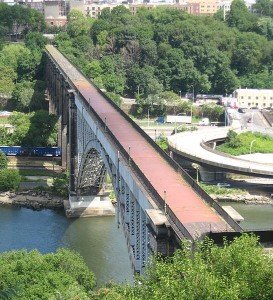 The Historic Districts Council, New York’s city-wide advocate for historic buildings and neighborhoods, has announced the 2012 Six to Celebrate, an annual listing of historic New York City neighborhoods that merit preservation attention. This is New York’s only citywide list of preservation priorities.
The Historic Districts Council, New York’s city-wide advocate for historic buildings and neighborhoods, has announced the 2012 Six to Celebrate, an annual listing of historic New York City neighborhoods that merit preservation attention. This is New York’s only citywide list of preservation priorities.
The six neighborhoods were chosen from applications submitted by neighborhood groups around the city on the basis of the architectural and historic merit of the area, the level of threat to the neighborhood, strength and willingness of the local advocates, and where HDC’s citywide preservation perspective and assistance could be the most meaningful. Throughout 2012, HDC will work with these neighborhood partners to set and reach preservation goals through strategic planning, advocacy, outreach, programs and publicity.
“Neighborhoods throughout New York are fighting an unseen struggle to determine their own futures. By bringing these locally-driven neighborhood preservation efforts into the spotlight, HDC hopes to focus New Yorker’s attention on the very real threats that historic communities throughout the city are facing from indiscriminate and inappropriate development.” said Simeon Bankoff, HDC’s Executive Director. “As the only list of its kind in New York City, the Six to Celebrate will help raise awareness of local efforts to save neighborhoods on a citywide level.”
Founded in 1971 as a coalition of community groups from New York City’s designated historic districts, the Historic Districts Council has grown to become one of the foremost citywide voices for historic preservation. Serving a network of over 500 neighborhood-based community groups in all five boroughs, HDC strives to protect, preserve and enhance New York City’s historic buildings and neighborhoods through ongoing programs of advocacy, community development and education.
The Six to Celebrate will be formally introduced at the Six to Celebrate Launch Party on Wednesday, January 18, 2012, 5:30-7:30pm at the Bowery Poetry Club (308 Bowery at East First Street). For more information or tickets, visit www.hdc.org.
The 2012 Six to Celebrate (in alphabetical order):
Bay Ridge, Brooklyn
Elegant rowhouses, Victorian-era mansions and pre-war apartment buildings combine with parks, vibrant commercial streets and impressive institutional buildings to make Bay Ridge a quintessential New York City neighborhood. For more than 30 years, the Bay Ridge Conservancy has been working to preserve and enhance the built environment of this architecturally and ethnically diverse area.
Far Rockaway Beachside Bungalows, Queens
Once upon a summertime, Far Rockaway was the vacation spot for working-class New Yorkers. Although recent decades have erased much of this history, just off the Boardwalk on Beach 24th, 25th, and 26th Streets rows of beach bungalows built between 1918 and 1921 still stand. The Beachside Bungalow Preservation Association is seeking to preserve and revitalize this unique collection of approximately 100 buildings.
Morningside Heights, Manhattan
Situated between Riverside Park and Morningside Park, two scenic landmarks designed by Frederick Law Olmsted, and developed mainly between 1900 and 1915, Morningside Heights is characterized by architecturally-unified apartment buildings and row houses juxtaposed with major institutional groupings. The Morningside Heights Historic District Committee is working towards city designation of this elegant neighborhood.
Port Morris Gantries, The Bronx
In the South Bronx neighborhood of Port Morris, a pair of ferry gantries deteriorating in an empty lot may seem an eyesore to some, but the Friends of Brook Park sees them as the centerpiece to an engaging public space. Taking inspiration from other New York City waterside parks, this new park will combine recreation, education, and preservation of New York’s history for residents and visitors alike.
Van Cortlandt Village, The Bronx
Once the site of Revolutionary War-era Fort Independence, Van Cortlandt Village developed into a residential enclave in the 20th century. Built on a winding street plan designed by Frederick Law Olmsted, responding to the hills and views of the area, the neighborhood consists of small Neo-Colonial and Tudor revival homes and apartment buildings, including the Shalom Alecheim Houses, an early cooperative housing project. The Fort Independence Park Neighborhood Association is seeking to bring awareness to the neighborhood’s historic and architectural value as well as nominate it to the National Register of Historic Places.
Victorian Flatbush, Brooklyn
Located in the heart of Brooklyn, Victorian Flatbush is known for being the largest concentration of Victorian wood-frame homes in the country. The area presently has five New York City Historic Districts, but the blocks in between them remain undesignated and unprotected despite architecture of the same vintage and style. Six local groups representing Beverly Square East, Beverly Square West, Caton Park, Ditmas Park West, South Midwood and West Midwood have joined together with the Flatbush Development Corporation to “complete the quilt” of city designation of their neighborhoods.
 The High Bridge is scheduled to reopen. This bridge is not to be confused with the High Line in Manhattan which is not a bridge. The High Bridge is a closed pedestrian crossing connecting the Bronx and Manhattan. The 1200 foot span was built in 1848 and is the oldest bridge in the city. It was constructed as part of the Croton Aqueduct system which carried water from Westchester to New York City.
The High Bridge is scheduled to reopen. This bridge is not to be confused with the High Line in Manhattan which is not a bridge. The High Bridge is a closed pedestrian crossing connecting the Bronx and Manhattan. The 1200 foot span was built in 1848 and is the oldest bridge in the city. It was constructed as part of the Croton Aqueduct system which carried water from Westchester to New York City.
.jpg)



